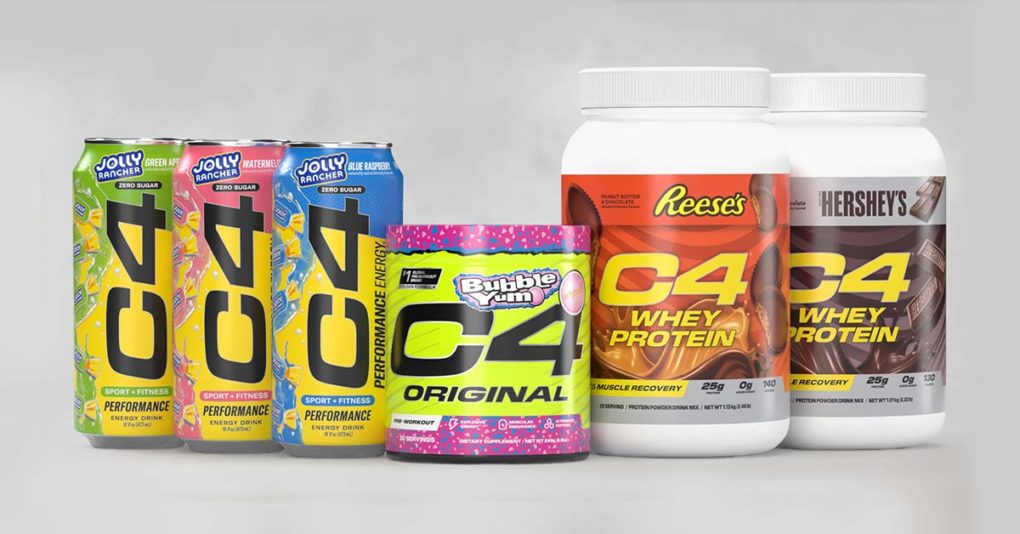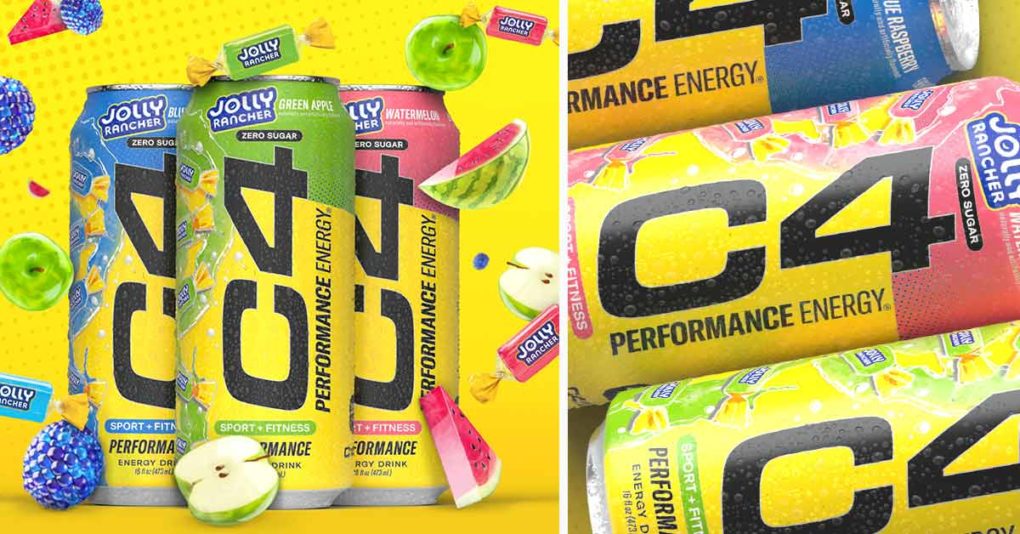“You got chocolate in my C4!” “You got C4 in my chocolate!”
That may not be the next big quotable commercial slogan, but it is part of the latest line launch from C4 Energy, which announced today several new drinks and powders featuring licensed flavors from the Hershey’s portfolio.
The co-branded line includes three ready-to-drink Jolly Rancher flavored C4 Performance Energy drinks (in Blue Raspberry, Green Apple and Watermelon varieties), a Bubble Yum flavored pre-workout powder mix, and Hershey and Reese’s flavored protein powders – the first protein products launched under the C4 brand.
The 16 oz. energy drinks are rolling out in retail exclusively at H-E-B, and are also sold online via Amazon and direct-to-consumer, with plans to expand into Walmart, 7-Eleven, Albertsons, Kroger, Hy-vee, Giant Eagle, Market Basket, Stater Bros, Royal Farms, Hannaford, Kum n Go, and Casey’s stores later this year.
Meanwhile, the Bubble Yum flavored pre-workout powder is available via the brand’s website at Cellucor.com and at GNC stores, while the protein powders will launch at GNC and The Vitamin Shoppe this fall. Additional co-branded product launches may be forthcoming as well.
Teaming with Hershey’s is the latest licensed flavor play from Nutrabolt-owned C4, which has previously partnered with legacy candy and snack brands for Skittles, Starburst and Popsicle flavored energy drinks.
According to Kyle Thomas, global chief commercial officer at Nutrabolt, embracing licensed flavors has been a major boon to the growth of C4, as well as the broader energy drink set, with roughly 60-65% of sales for these co-branded flavors being incremental to the category.
“That’s something that is appealing, obviously, to the retailer,” he said. “And I think that’s what you’ve seen over the last couple of years; the growth from performance energy as a whole, what we would call Performance Energy 2.0, is driving 80% of the category growth, and then out of that is these flavor collaborations that drive a ton of incrementality into the space.”
The reasons why these candy-flavored offerings are resonating can run deeper than one might think at first. While they obviously benefit from pre-existing brand affinity, Thomas suggested that there’s also a blend of childhood nostalgia, curiosity around the flavor and increased “optionality” at play here.
For their partners, Thomas suggested that companies like Hershey’s benefit from expanded presence in the store and by bringing their brand name into new categories they were less likely to branch into on their own.
“As a consumer, just seeing the name of Hershey on anything gives you a sense of trust that the products are going to taste good,” he said.
C4 is far from the only energy drink maker to work the nostalgia factor with this strategy – competing lifestyle performance brand Ghost arguably served as a pioneer of the trend in the energy space with a slate of co-branded launches with Sour Patch Kids, Warheads and more, while emerging brand RYSE has similarly embraced licensing with Kool-Aid, RingPop and Sour Punch varieties.
Energy and supplements category observer Joshua Schall, owner of J. Schall Consulting, noted that co-branded products aren’t necessarily a new trend in CPG – plenty of candy brands have been lending their logos to cake mixes, cereals and more for decades, however its emergence in energy has been more recent, with Ghost having a commanding “head start” in driving the trend.
“The importance always on these flavor licenses is that you obviously get to leverage an extremely high visibility, high awareness brand,” Schall said “It’s something that a consumer has a connection with, has a memory of, has a moment in their life that they’ve had and they want to relive that – or they both kind of have confidence that it’s going to taste a certain way.”
While co-branded offerings are still in the early stages, as they become more normalized Schall suggested that brands and retailers will have to think more carefully about the placement and performance of individual SKUs.
“Eventually your cooler has to still have a spread or a diversification or some optionality, and you can’t have the whole cooler be these things,” he said. “So then in the mind of a buyer, these merchandisers, they’ll look at it as just another product feature.”
For C4, however, licensing has not overtaken its original flavor innovation – Thomas noted that the brand’s Frozen Bombsicle variety is still its number one selling item, adding that the company has several new launches of fresh flavors slated for 2025.
Beyond energy, however, the Hershey’s collaboration is also providing C4 an avenue to enter a natural adjacency, protein powders. Although its parent company Nutrabolt already makes protein mixes under the Cellucor brand, it had held off from putting the format under the C4 name until now.
Part of the motivation to add protein, Thomas said, is due to the rise of GLP-1 drugs, which require users to consume high-protein diets in order to prevent loss of muscle mass. As well, the growth of the C4 brand has prompted the company to capitalize on its rising awareness with protein as well as pre-workout and RTD energy.
“The brand equity that we have in the active nutrition side is really more driven by the consumer recognizing and understanding that brand, and being able to say ‘I trust and I know this is going to be something that’s good, and it’s going to be focused on performance, and it’s going to have the best ingredients possible,’” Thomas said. “So from a decision lens, it made the most sense to have that ladder back to the C4 brand itself.”

